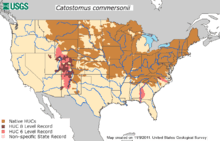White sucker
| White sucker Temporal range: Early Pleistocene to Recent | |
|---|---|
 | |
| Scientific classification | |
| Kingdom: | Animalia |
| Phylum: | Chordata |
| Class: | Actinopterygii |
| Order: | Cypriniformes |
| Family: | Catostomidae |
| Genus: | Catostomus |
| Species: | C. commersonii |
| Binomial name | |
| Catostomus commersonii Lacépède, 1803 | |

The white sucker (Catostomus commersonii) is a freshwater Cypriniform fish inhabiting the upper Midwest and Northeast in North America, but is also found as far south as Georgia and New Mexico in the south and west. The fish is commonly known as a "sucker" due to its fleshy papillose lips that suck up organic matter and aufwuchs from the bottom of rivers and streams.
Other common names for the white sucker include bay fish, brook sucker, common sucker, and mullet. The white sucker is often confused with the longnose sucker (Catostomus catostomus), because they look very similar.
Description
The white sucker is a long, round-bodied fish with a dark green, grey, copper, brown, or black back and sides and a light underbelly. The fish also has typical features of primitive cypriniformes fishes, such as a homocercal tail, cycloid scales, as well as dorsal, pectoral, and pelvic fin rays.[1] When fullgrown, it can reach lengths between 12 and 20 inches long and weigh anywhere from 2 to 6 pounds. The fish's suckermouth with its fleshy lips are located in the inferior position at the bottom of its head, as the fish obtains its food from bottom surfaces.[2] These fish are also commonly mistaken for different types of suckers and redhorse, but can be distinguished by the complete lateral line system containing 55-85 small scales.[3]
Distribution and habitat
Since the fish is a bottom feeder and has no preferential food options, it is highly adaptable to different habitats and changing environmental influences.[4] Generally, however, White suckers are found in small streams, rivers, and lakes in the Midwest and East Coast of the United States.[5] The White sucker is also relatively tolerant of turbid and polluted waters.[6]
Diet habits
The white sucker is a bottom feeder, meaning that it uses its fleshy lips to suck up bottom sediments and other organisms that may be located there. It will eat almost anything it can, but most commonly small invertebrates, algae and plant matter. Larger predatory fish species such as walleye, trout, bass, northern pike, catfish, muskellunge, and sauger naturally prey on the white sucker.
Reproduction
The white sucker usually spawns in shallow water or streams in April and May; spawning may possibly be initiated by temperature changes and runoff from early snow melt.[7] It is not uncommon for two or more males to gather with one female, who releases up to 10,000 eggs that can be fertilized by the gathered males.[8]
Importance to humans
A very common fish, the white sucker is usually not fished for food, though some consider it good to eat. It is most often used as bait; the young are sold as sucker minnows. When it is eaten by humans, it is usually processed and sold under the name of mullet.
Fossil record
Fossils of this fish in the United States occur as early as the Early Pleistocene (1.8 million years ago).[9]
References
- ↑ Jon Grinnell, Flowyd Downs. "Vertebrate Zoology Biology 242 Laboratory Instructions." Gustavus Adolphus College
- ↑ Grinnell
- ↑ Rook, J.S.E. "Catostomus commersoni/White Sucker". 1999. http://www.rook.org/earl/bwca/nature/fish/catostomuscom.html
- ↑ Rook, J.S.E.
- ↑ Minnesota Department of Natural Resources. "White Sucker" 2012.
- ↑ Rook, J.S.E.
- ↑ Rook, E.J.S.
- ↑ Minnesota DNR
- ↑ .
- "Catostomus commersonii". Integrated Taxonomic Information System. Retrieved 17 June 2006.
- Froese, Rainer and Pauly, Daniel, eds. (2006). "Catostomus commersonii" in FishBase. 06 2006 version.
External links
- "Hybrid 'Muttsucker' Has Genes Of Three Species". Science Daily. Aug 15, 2008. Retrieved 2008-08-15.
- Species profile by Earl J.S. Rook
- Wisconsin Sea Grant Fish of the Great Lakes species profile
- Nova Scotia Department of Agriculture and Fisheries factsheet
- World Register of Marine Species entry